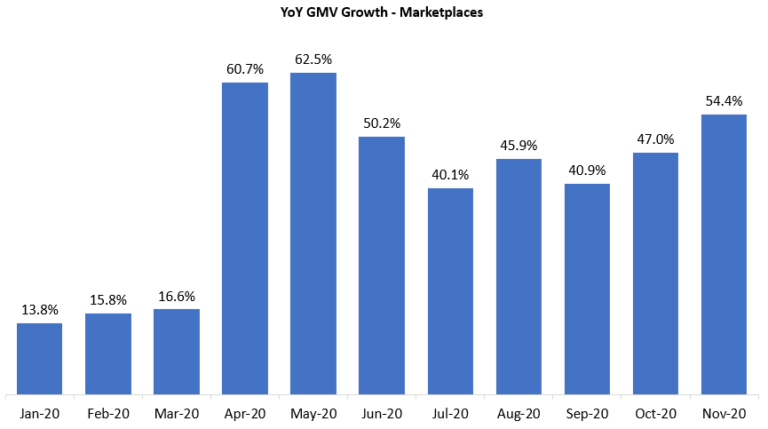Without a powerful presence in the right spaces, retail businesses may feel their customers are nowhere to be found.
However, by examining omnichannel commerce trends and understanding how to apply resulting action items, brands should feel empowered. Their customers are, in fact, everywhere.
- Reliable information about products; and
- Realistic expectations from brands.
Therefore, customers should have similar shopping experiences whether they browse brands in-store, on a direct-to-consumer (D2C) site, through another channel like Amazon, or on a social media platform like Instagram.
Customers are then more likely to return and remain loyal as well as motivated to share their positive experiences with others.
1. D2C: Cut Out the Middleman
If there is one thing retailers have learned in 2020, it is that having a direct line to their customers can have a major impact on loyalty and retention.
The “middleman,” in this case, are online platforms and physical department stores that used to be crucial to the supply chain.
By making the cut, brands can:
- Reduce costs;
- Improve efficiencies; and
- Get closer to their customer.
However, this doesn’t necessarily mean the old online marketplace is no longer important. Omnichannel commerce trends show there are more ways than ever to reach the customer — with customers in more places than ever.
Brands need to carefully consider their omnichannel commerce strategy to ensure they can meet the customer at their moment of inspiration.
Sometimes, that means selling directly to the customer through D2C channels, such as:
- An online store;
- A branded app; or
- Through social commerce.
In turn, brands are learning more about customer needs, collecting more data to enable personalized experiences, and generally improving the chances of conversion.
2. Social Commerce: Sell Where You Find Customers
Perhaps the pandemic caused a lasting uptick in your time spent online — but you’re not alone. Omnichannel commerce trends will likely be a huge driver of screen time records for many. Consumers and brands alike will be wary to let go of their embrace of social commerce and the associated benefits.
Social commerce, or selling directly from social media platforms, is another way of cutting out the middleman in digital retail. These social networking platforms have billions of daily users who spend hours scrolling through feeds for the goal of feeling engaged and entertained.
This presents brands with the opportunity to make deeper emotional connections with their audience through the delivery of personalized product content — all while gaining more robust user data and exposure.
Think about opportunities to speak directly to your potential customer and meet them exactly where and when they need you.
For example, this can occur on Facebook Messenger by having customers answer sticking product questions or with a “buy now” button on an Instagram post.
Social commerce opens a world of possibilities for tech-savvy brands selling on the digital shelf. By harnessing the native functionality of social media platforms, brands can effectively target product content to make an even stronger connection with their audience.
3. BOPIS: Adjust to Customer Expectations
The buy online, pick up in store (BOPIS) shopping option is hardly new. Major retailers have been offering click-and-collect services for a while now.
However, BOPIS has grown exponentially since the COVID-19 pandemic began and has changed the face of retail — with many shoppers reluctant to linger in brick-and-mortar stores.
Surveys show that shoppers are more likely to purchase from a retailer with omnichannel services. Contactless curbside pickup is also rated one of the most desirable options.
With 62% of consumers embracing BOPIS options as a way to reduce exposure to the coronavirus, according to a survey by Qudini, experts on omnichannel commerce trends believe the pandemic could be a catalyst for a new, more omnichannel-focused future.
But, if you feel you need to better your BOPIS capabilities, this requires tighter orchestration on the back-end. It also demands:
- A robust logistics chain;
- Stock tracking and shipping handled with confidence; and
- Most importantly, that the customer experience is seamless at each end of the purchase.
Customers increasingly assume they’re dealing with one unified brand, not separate channels, and any hint of misalignment will impact their likelihood of returning for further purchases.
While BOPIS is an impressive and desirable proposition for customers, for the retailer it requires some hefty lifting to connect online and in-store inventory.
4. Automation and AI: Power the New Shopping Experience
For the most part, consumers are comfortable with technology these days. If anything, the pandemic has caused any stragglers to pick up the pace.
A pre-pandemic Nielsen study found that a majority of global consumers were ready to try out augmented reality (AR) and virtual reality (VR) technology as part of their shopping experience.
In fact, half of respondents say they’re seeking out AR and VR to assist, amplify, and augment their daily lives — with 51% willing to use this technology to assess product choices.
“AI-driven big data retailing has been maturing for some years now, with major retailers relying on advanced analytics to understand what should be stocked in their stores and drive efficiencies in logistics,” writes Bernard Marr for Forbes.
“Newer developments have seen this technology moving from back-of-house to front-of-house, with customer-facing initiatives, such as chatbots and virtual assistants. Likewise, while robots have been hanging out in warehouses and stock rooms for a while assisting with inventory management, in 2021 we can expect to see them taking to the shop floor, too,” Marr writes.
The Nielsen study shows that consumers will adopt augmented store technology “if it alleviates time and provides seamless interactions,” which means brands looking to harness omnichannel trends need to be ready before jumping into the world of tech-driven shopping.
So, before making the jump, brands must ensure their content translates to multiple platforms and their customer experience is seamless — no matter how or where interactions occur.
5. CommerceXM: Empower Your Brand to Win on the Digital Shelf
With so many new opportunities to get to know customers and sell to them, brands need to be cognizant of how they coordinate their content and sales channels.
One way that savvy brands are doing this is by harnessing Commerce Experience Management (CommerceXM).
An integrated CommerceXM platform like Salsify empowers brands to win on the digital shelf by helping them tailor experiences for customers at every stage of the buying journey.
A single digital touchpoint can make or break a brand’s opportunity for consideration, purchase, or endorsement. Brands must catch up, break down the sales and marketing silos, and start building a robust omnichannel commerce strategy.
Watch the on-demand webinar, “The Era of Omni-Commerce: New Insights for Dominating the Digital Shelf and Beyond,” to learn more about omnichannel commerce trends.




![[Guest Blog] Reach a Global Audience With International SEO](https://technobabble.com.au/thegatewaynetau/wp-content/uploads/sites/11/2021/02/guest-blog-reach-a-global-audience-with-international-seo-768x340.jpg)